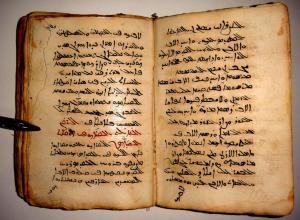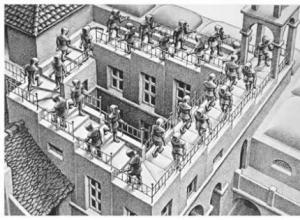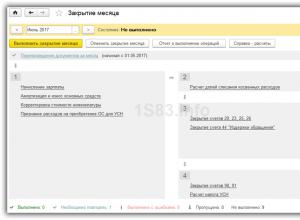Sea vessel sea trials program. Sea trials and delivery of the vessel. Mooring tests of ships
Sea trials are a technological stage of acceptance tests, the purpose of which is to check the operation of the equipment and its parameters under running conditions, as well as to check the seaworthiness of the vessel (buoyancy, stability, controllability, propulsion, maneuverability, strength on waves). Sea trials are divided into factory and acceptance tests.
During the factory sea trials, adjustment and adjustment work is carried out and equipment is prepared for sea acceptance tests. During factory sea trials, the specifications of the main ship engines are checked in terms of power, fuel and oil consumption, and time to develop full power. This check is carried out in various operating modes: at economic speed, cruising speed, full and full speed with all engines running, reverse gear. Simultaneously with checking the power plant, the speed and maneuverability of the vessel are determined. The speed is determined by passing the measuring line indicated by leading signs. At a speed of 18 knots, the ship must pass a measuring line of one mile, at a speed over 18 to 36 knots - two miles, at a speed over 36 knots - three miles. This ensures sufficient accuracy in determining speed. Speed is determined as the average value from measurements on several tacks.
The sea trials program provides for determining the agility of the vessel at low, economic, cruising and full speed. Agility is characterized by circulation elements: circulation diameter (the distance between the return course lines when changing direction by 180°), circulation duration, roll angle during circulation, loss of speed. The circulation diameter is determined in terms of the lengths of the ship's hull. The measurement is carried out by the ship's standard radar stations or special equipment.
The length of the hull also determines the coasting of the vessel due to inertia. When checking inertia, the time from the moment the command is given until the vessel comes to a complete stop or reaches a certain speed is also determined.
Inspection and final acceptance of equipment during sea acceptance tests are carried out while the ship is moving under conditions that ensure that nominal parameters are obtained. According to the requirements of regulatory documents, equipment is tested under normal climatic conditions (atmospheric pressure 1.01 105 Pa, temperature 293 K, relative humidity 70%), with a wind force of no more than 3 points on the Beaufort scale, taking into account the depth and speed of the current in the test area.
At the end of the vessel's acceptance sea trials, an inspection of the main and auxiliary mechanisms and devices is carried out according to the list compiled by the selection committee. The list contains those mechanisms and devices in the operation of which deficiencies have been noticed. The audit consists of revealing these mechanisms and eliminating the shortcomings noticed by the commission.
After the inspection, the ship goes to the control exit. If the commission has no more comments, then a certificate of delivery and acceptance of the vessel is signed.
Determining the duration of vehicle delay at an intersection
The magnitude of the transport delay in the i-th direction is determined by the formula: where is the effective share in a given phase of the regulation cycle; Phase I: Phase II: With the introduction of phased traffic light regulation, the number of collisions decreased from 4027 to 1196 and the danger level of the intersection became simple m=34. According to the calculation results...
Sea trials and delivery of the vessel
Sea trials are a technological stage of acceptance tests, the purpose of which is to check the operation of the equipment and its parameters under running conditions, as well as to check the seaworthiness of the vessel (buoyancy, stability, controllability, propulsion, maneuverability, strength on waves). Sea trials are divided into factory...
Safety requirements for lighting and electrical equipment
The tools used and the organization of work with them must meet the requirements of regulatory documentation, technical specifications and the requirements of current rules and regulations. Hand tools (hammers, chisels, punches, etc.) should not have: - damage to the working surfaces (potholes, cracks, knocked down and beveled...
After completion of installation and outfitting work on the ship, closing of construction certificates, mooring tests of the ship are carried out in order to check in operation and determine the main characteristics of mechanisms, devices, equipment, instruments, systems, electrical equipment and the entire ship as a whole for compliance with the drawings, diagrams, specifications of the ship, forms and technical conditions for their delivery.
In order to save the motor life of standard power sources, electrical equipment is powered from shore-based power sources.
Based on the results of mooring tests, the readiness of the vessel for factory and sea trials is determined.
Factory and sea trials are carried out for the purpose of adjusting, setting up, testing the technical equipment of the vessel, as well as determining the main characteristics of the technical equipment and the entire vessel as a whole.
At the end of the tests, an audit of the technical means is carried out through a control opening and inspection of the internal cavities and rubbing parts.
After the inspection of technical equipment and final finishing and painting of the premises and the entire vessel as a whole, the acceptance certificate is signed and the vessel is handed over to the Customer.
In order to save material and financial costs for serial ships, acceptance tests are carried out at the plant wall without the ship moving, using simulation testing methods. For this purpose, simultaneously with mooring and sea trials of technical equipment, comparative tests are carried out in order to check the compliance of the loads and operating parameters of mechanisms and devices obtained during simulation testing methods in the plant’s water area, with the loads and parameters obtained under sea test conditions carried out at the same site. same ship.
Simulation tests of the main ship's power plant are carried out on parameters corresponding to the parameters obtained during bench tests of the engines. The creation of these parameters on a ship located at the wall of the plant is achieved through the use of an unloading device. Simulation tests of the steering device are provided using a loading device. Simulation tests of the anchor device are provided by the method of tensioning the anchor chain. The test parameters for the steering and anchor devices must correspond to the test parameters under sea conditions. Checking the anchor device at the working depth of the anchor is carried out at the control exit during the first operational voyage of the vessel.
Conclusion
The design technology and organization of ship construction are developed taking into account the production conditions of the building plant and the structural and technological characteristics of the ship.
The main fundamental decisions of the design technology and organization provide for the reduction of labor costs and the duration of ship construction by performing the greatest possible amount of work in workshop conditions, priority placement of the most complex work (formation of the hull, and saturation of the III construction region, assembly and saturation of the superstructure) also in workshop conditions , performing work using a mechanized method, using advanced technological processes, reducing the amount of work performed afloat, etc.
Preliminary processing of metal is carried out on mechanized lines.
Cutting of parts, depending on the configuration and thickness, is carried out using guillotine shears, press shears, presses or using thermal cutting on Kristall machines; packaging is carried out in containers.
Assembly and welding of units and sections is carried out on assembly plates, individual and universal beds, jigs and a mechanized line for assembly and welding of flat sections with the widespread use of semi-automatic and automatic welding. Editing of hull structures is carried out using the non-impact method.
The formation of the corps as a whole is carried out from construction areas (enlarged blocks), construction areas - from sections. At the same time, construction areas are maximally saturated with mechanisms and equipment with a high percentage of completion of construction work.
The production of pipes is carried out according to technological maps using group launches of pipes into production, downhole pipes - according to templates on site, individually.
Installation work is carried out in workshop conditions and on a ship. Preliminary installation is carried out in the workshop for assembling units and mounting blocks. Installation work is primarily carried out in saturated areas of the vessel (engine room, superstructure).
The manufacture of finishing products and equipment for ship premises is carried out on machine tools as part of mechanized lines. The technology involves the use of a modular system for the formation and equipment of residential and office premises, the production of standardized building elements, packages and insulation panels in a workshop environment, and the use of standardized plastic furniture.
Painting work is carried out primarily using mechanized equipment at the sites where hull structures are assembled in the workshop, at vessel formation positions on an open slipway and afloat. Drying of painted products is natural.
Vessel tests are carried out in the water area of the enterprise using simulation methods. The specified method is used to test  main ship propulsion units, steering and anchor devices and radar equipment using a radio range.
main ship propulsion units, steering and anchor devices and radar equipment using a radio range.
 List of used literature
List of used literature
1 Fundamentals of shipbuilding technology: Textbook under general. ed. V.F. Sokolova, St. Petersburg: Shipbuilding, 1995.
2 Handbook on assembly and welding equipment of shipyard workshops. L.: Shipbuilding, 1983.
3 Handbook on technological design of shipyards and workshops. A.K. Syrkov, L.: Shipbuilding, 1980.
4 Fundamentals of shipbuilding technology: Textbook under general. ed. V.D. Matskevich, St. Petersburg: Shipbuilding, 1971.
5 Guidelines for a course project on shipbuilding technology (electronic version).
6 Manufacturing technology of ship hull structures. V.V. Ivannikov, M.G. Shaidullin, P.L. Spehov, B.R. Timofeev, - Gorky: Gorkov. Polytechnic Institute, 1988

Annex 1

9.2. ACCEPTANCE TESTS OF VESSELS
Acceptance tests are carried out in two stages: mooring
Tests; sea trials and acceptance.
In order to reduce the labor intensity of work and the time required to hand over ships after construction or repair, GOST 21792-76 allows for main marine diesel engines to carry out simulation tests in running modes on moorings. During simulation tests, operational mooring and sea trials of the diesel installation are not carried out.
Acceptance tests of the power plant and the vessel as a whole are carried out according to a program developed by the designer or the plant, agreed upon and approved in the prescribed manner. The tests are supervised by a commission consisting of representatives of the plant, the customer and the USSR Register. The acceptance testing program determines the tasks, scope and order of all stages of testing and acceptance of the vessel, establishes a list of documentation presented before each stage of testing, as well as the volume of measured indicators and the range of measuring instruments used, the list of which basically corresponds to that indicated in table. 9.1. For test modes lasting up to 1 hour, measurements are taken once, over 2 hours - every 2 hours.
Mooring tests are carried out to check: the completeness and quality of installation of the main engines and auxiliary units with the mechanisms, systems and devices serving them; compliance of energy equipment, systems and devices with technical specifications for delivery, operating instructions and drawings; serviceability of the ship's power and propulsion systems; readiness of equipment, systems and devices for sea trials of the vessel. Before mooring tests, the commission is presented with: technical conditions for the supply of equipment, maintenance instructions, forms, passports, drawings, descriptions, diagrams and other documentation in accordance with the list of reporting technical documentation, as well as a list of deviations from the approved technical documentation.
Auxiliary power equipment (boiler unit, pumps, separators, compressors, etc.) is tested in operation for its intended purpose. The operating parameters obtained during testing must not exceed the values specified in the instructions, data sheets or forms. The modes and duration of their operation, as well as the list of measured parameters, are determined by their purpose and are established by the mooring test program. Mechanisms, systems and devices, the operation of which is not related to the progress of the vessel, are accepted definitively during mooring tests. Auxiliary generators are checked both in single and in parallel operation. Checking the operation of the main engines is carried out after checking the operability of the mechanisms, systems and devices that serve them.
The load of diesel installations during mooring tests in accordance with GOST 21792-76 should change:
For main diesel engines and diesel-geared units operating on a fixed-pitch propeller (FPP), - according to the mooring screw characteristic of the form A^p =,/ (“);
For main diesel engines and diesel-geared units operating on a controlled-pitch propeller (CPP), - according to the screw characteristic of the form N =.f(n), passing through the rated power mode, or according to the load characteristic of the form N =.f(H/ D) for n = const;
For main and auxiliary diesel engines operating on a generator, according to the load characteristic of the form /V -/(L/cr) with n = const.
Mooring tests of diesel installations, the load of which varies according to the screw characteristic, are carried out in the modes indicated in Table. 9.2, according to load - in the modes indicated in table. 9.3.
Sea trials and acceptance are carried out after elimination of the comments identified during the mooring tests and preparation of technical documentation (measurement tables, protocols or reports) based on the results of mooring tests. Sea trials are carried out to check: the operation of diesel engines on the types of fuels provided for in the design documentation; main performance indicators of the power plant; reversible qualities of main engines and rotary propellers; propulsion and maneuverability of the vessel.
The modes and duration of sea trials of ships when the load of the main engines changes according to the propeller characteristics are given in Table. 9.4, for load - in table. 9.5.
In order to save money and time, sea trials are replaced with simulation ones. Simulation tests in running modes on moorings are carried out for diesel engines powered by a propeller, if the running conditions of the latter and the running characteristics of the diesel engine, passing through the regime of rated power and rotation speed, can be reproduced with a stationary ship using simulation tools or methods . The selected simulation test method must be verified through comparative tests with and without the vessel moving. The results of comparative tests must be approved by the Register, after which the selected simulation test method can be extended to the entire series of ships of this type. As a means of simulation, a CV propeller is used, which allows the main engine to be loaded in running modes when the vessel is stationary.
Diesel installations of serial ships are allowed for simulation tests: after registration of acceptance documentation for the construction (repair) and mooring periods for mechanisms, systems and devices servicing the diesel engine; bench or ship running; adjustment and testing of the diesel engine in operation under ship conditions together with servicing mechanisms within 1 ... 2 hours of eliminating identified defects and comments. Simulation tests of diesel installations should be carried out at the load conditions specified in table. 9.6.
During the period of simulation tests, the accuracy of reproduction of the
The howl of the screw characteristics passing through the modes of rated power and rotational speed should be controlled by the correspondence of the rotational speed and the main parameters of the diesel engine to the form or passport data obtained during the period of sea trials.
In view of possible deviations in the technical condition of engines on individual ships after construction or after they have been repaired, control of engine load conditions during simulation tests should be carried out using a set of indicators, and not just one of them. Thus, for the main engine 8 DR 43/61-B 1, a set of such indicators is given in table. 9.7.
During simulation tests, it is necessary to observe the following sequence of reaching a steady state: set the required rotation speed; rotate the propeller propeller blades up to 3.5 divisions “forward” according to the remote pitch indicator and record the fuel consumption and exhaust gas temperature at a steady state of engine operation. If they are lower than those indicated in the table. 9.7, then the rotation of the rotary propeller blades must be increased. Deviations should not be allowed Notes: 1. For diesel installations of ships with a power of 4000 kW or more
And above tests in mode 4 can be carried out at a torque iio of more than 85 rated. 2. Checking the operation of a diesel engine in mode S is allowed to be carried out during the period of control tests of the vessel in free water only
But the rotation frequency.
rotation hours o i of a given power of more than +3 in intermediate modes - ±5. At nominal and maximum load modes from -
The power deviation should be 5% less than the rated value.
After completion of sea or simulation tests and completion of all the checks provided for in the program, a technical inspection is carried out and, if necessary, a control opening and inspection of the parts and assemblies of the diesel engine and the mechanisms and devices that serve it. The list of mechanisms and devices subject to control opening and inspection is determined by the selection committee and agreed with the Register.
Acceptance tests are completed with control tests. which are carried out while the vessel is moving in free water or using the simulation method (in agreement with representatives of the customer and the Register, depending on the results of the control opening and technical inspection of components and mechanisms). Control tests are carried out in full speed mode at rated speed and in reverse mode. The duration of tests at full speed is: 1 hour for engines with power up to 150 kW, 2 hours - from 151 to 4000 kW, 3 hours - above 4000 kW. In reverse mode, the test duration is 0.25 hours, regardless of engine power.
The materials obtained during acceptance tests are subject to processing for the purpose of: determining the average values of the measured parameters; design parameters and characteristics for measured parameters; decoding of all recordings on oscillograms and chart tapes; constructing reporting charts; determining the degree of accuracy of the obtained measurement results. The results of acceptance tests are documented in an act and report on the tests of the vessel, including sections: general data; EC test results; comments on the operation of the power plant; conclusions and recommendations. The appendix to the report contains summary tables of the main parameters, as well as graphs and diagrams characterizing the operation of the power plant during testing.
Maintenance of the ship's power plant after construction is carried out by the plant's commissioning team, and after repairs - by the ship's crew.
When accepting a new vessel, the crew must familiarize themselves with: the power plant, auxiliary equipment, systems and technological equipment of the vessel; device and instructions for the technical operation of equipment and systems; types of fuels and lubricating oils recommended for equipment operation; nomenclature and completeness of control and measuring instruments; acceptance testing program, test methods, list of measured parameters and instrumentation used; barrier parameters of power equipment specified in operating instructions, passports, forms or technical specifications (TU).
The ship's crew is obliged to: actively assist in the correct organization and conduct of all types of acceptance tests in full scope of the approved program; make proposals to the selection committee on the list of mechanisms and devices that require control opening; take part in inspections of mechanisms and devices during control openings; require testing of the operation of engines and steam boilers on all types of fuels provided for in the design documentation.
Abstract on the topic:
TESTS AND SUBMISSION OF VESSELS
Preparation for passing tests
During the construction of a vessel, constant technical control is carried out on products that are intermediate products of hull processing, assembly and welding, mechanical installation and other shops. The scope of inspections during construction is regulated by a list of mandatory acceptances, which is compiled jointly by the construction company and the customer. Technical control ends with testing and delivery of the vessel. The purpose of the tests is to verify compliance of the technical and operational characteristics of the vessel with the characteristics specified in the design documentation.
Before testing the vessel, the installation of all pipelines, main and auxiliary machinery systems must be completed; equipment of premises; impermeability tests; installation of ship equipment and practical items. All completed during the construction process. work included in the list of mandatory acceptances must be documented with appropriate documents - certificates signed by the quality control department and representatives of the customer.
To hand over the vessel to the customer, a delivery commission, a test batch and a responsible delivery person are assigned. The commission includes assistants to the responsible commissioner for hull and electrical parts, a commissioning mechanic, foremen and workers from highly qualified specialist installers for main and auxiliary mechanisms, ship devices, systems, and electrical equipment. The test batch consists of specialists who monitor the operation of individual units during testing. All deviations from normal operating conditions recorded by the test batch are reported to the responsible commissioner or chief mechanic. At the same time, a test log is maintained in which the test results are recorded. The scope and sequence of tests are established by a special program, which is the guiding document for testing.
The acceptance of the vessel is carried out by an acceptance committee consisting of representatives of the customer and the Register. Before the start of testing, the acceptance committee must be presented with a construction contract, a set of drawings of the general layout of the vessel, a book of installation certificates, a log of the weight load of the vessel, a log of alterations and approvals, bench test reports for main and auxiliary mechanisms and other mechanical equipment, as well as instructions, diagrams, descriptions, forms of equipment and passports of control and measuring instruments. After reviewing all submitted documents, the commission makes a decision on readiness to carry out acceptance tests.
In addition to preparation for testing, the vessel testing period includes the following stages: mooring trials, sea trials, inspection, control exit, control tests.
Mooring tests
Mooring tests are a technological stage of acceptance tests, the main purpose of which is to check the quality of ship construction, installation and adjustment of equipment; preliminary load testing of the main power plant and auxiliary mechanisms; checking the operation of systems and devices that ensure the survivability of the vessel; preparing the vessel for sea trials.
To carry out mooring tests, special places with sufficient depth are prepared, equipped with coastal mooring devices and having a quay of durable construction.
Mooring tests are carried out separately for mechanical, electrical and hull parts. The mechanical part is tested first, starting with emergency systems and mechanisms that ensure the safety of the vessel during testing (fire system, flooding and water pumping systems). After this, testing of auxiliary energy means takes place: turbogenerators and diesel generators, auxiliary boilers, evaporators, desalination plants, etc. Tests of the main power plant are carried out last. Ship systems, pipelines, electrical networks, energy and survivability stations are tested simultaneously with the main mechanisms. Before testing the GTZA of a steam turbine installation, the operation of the shaft turning and shaft braking devices is checked, as well as the movement of the turbines into forward and reverse motion. During mooring tests of a steam turbine installation, hydraulic tests of pipelines of all systems are carried out, including fuel, fire, and steam; check the operation of auxiliary installations (start-up, feed, fuel pumps); carry out pumping of oil through the oil pipeline of the engine room; carry out hydraulic and steam tests of steam pipelines of the engine room; carry out tests of circulation and condensate pumps, as well as pipelines directly connected to turbines; carry out checking the power and lighting networks and starting the turbogenerator, as well as starting the GTZ for idling. Then the operation of the GTZ is checked at a rotation speed that is permissible according to the conditions of mooring reliability, the condition of coastal structures and the depth of the water area.
If the main installation on the ship is diesel, then at the beginning of its tests the serviceability of the shaft turning device, signaling of pressure drop and oil overheating, and turning off the fuel supply when the rotation speed increases above the permissible level are checked; engine starting qualities and starting air reserves. At the next stages, the operation of the main engines is tested at low and medium speeds. If there is an adjustable pitch screw or special unloading devices, the operation is also checked at full speed corresponding to the running mode.
On the hull part, during mooring tests, the displacement of the vessel is checked by measuring the draft according to the marks of the deepening, initial stability (by inclining method), as well as the operation of the anchor, steering, cargo, boat, mooring and towing, railing and awning devices, spars and rigging, outboard ladders, light and sound alarms, spotlights, running lights, bells.
When testing the steering device, the serviceability of the steering drive, the correct operation of the steering wheel position indicators and the operation of the limiters are checked. The anchor device is tested by etching and selecting one by one several links of the anchor chain on the brake band of the capstan or sconce capstan, checking the passage of the anchor chain links through the fairleads, screw stoppers and along the sprocket of the anchor mechanism. In the cargo device, the reliability of the operation of the drums and brakes of cargo winches, the reliability of fastening cargo booms in a stowed manner, and the ease of opening and closing cargo hatch covers are checked. For the lifeboat device, it is necessary to check the ease and correctness of the boats falling out, measuring the time of lowering and raising the boats, and checking the reliability of fastening the boats in a traveling manner.
Hull tests also include checking the operation of the galley, bakery, laundry and other living services on the ship. In addition, the reliability of the battening and tightness of doors, hatches, covers, portholes, etc. is tested. Household equipment is also checked: the reliability of its fastening, completeness.
Simulation tests
In domestic shipbuilding technology, a fairly large number of simulation tests have been developed, which have found wide application in world practice. Simulation tests are a type of vessel acceptance tests, in which the specification parameters of ship equipment are checked during mooring tests in shipyard water conditions that are as close as possible to full-scale ones. Simulation tests are carried out using special unloading or loading devices - simulators that reproduce the running conditions of the ship's equipment.
An unloading device is a special technological device used for simulation tests of the main power plant. The unloading device serves to create easier operating conditions for the equipment. Thus, to unload the propeller along the stop and torque to the calculated values, a reduction in the area of the propeller disk is used due to the ring attachment; a flow-directing chamber that ensures the flow of water to the propeller at a speed equal to its design axial speed; supplying compressed air to the propeller area in order to reduce the density of the water surrounding the propeller. The work of the propeller can also be made easier by reducing the draft of the vessel and, therefore, reducing the depth of the propeller.
Load devices create additional load to check the functionality of the equipment. For example, when testing diesel generators and turbogenerators, the load device is the shore network, where excess electricity is transferred from the vessel being tested.
Simulation tests of the anchor device on mooring lines are carried out in several ways: by securing the anchor chain on the shore while the main engine is running in reverse at design modes; hanging loads on a section of the anchor chain. The most promising method for simulating tests of an anchor device is considered to be a method using a universal loader located on a pontoon and representing a hydromechanical brake with remote control. This method has a number of advantages in terms of versatility, independence of the testing process, and accuracy of reproducing natural conditions.
Simulation devices are also used to test navigation and radar equipment, a gyrocompass, a hydrodynamic log, and hydroacoustic equipment.
To set up radars, special training grounds are set up, located outside the plant and equipped with special reflectors. The direction and distance to the reflectors are known. Radar stations detect reflectors, determine course directions and distances to the reflectors. The data is compared with the true values and adjusted based on station deviations to the required accuracy in determining the required parameters.
Hydroacoustic equipment is checked using a measuring device installed under the bottom of the vessel - a hydrophone, which measures the sound pressure of the vibrator of the hydroacoustic apparatus. Based on the measured sound pressure, the range of the hydroacoustic equipment is recalculated.
Simulation tests approximately halve the duration of the acceptance period, make it possible to create stable test conditions, improve the quality of testing and reduce the consumption of fuel and energy resources.
Sea trials and delivery of the vessel
Sea trials are a technological stage of acceptance tests, the purpose of which is to check the operation of the equipment and its parameters under running conditions, as well as to check the seaworthiness of the vessel (buoyancy, stability, controllability, propulsion, maneuverability, strength on waves). Sea trials are divided into factory and acceptance tests.
During the factory sea trials, adjustment and adjustment work is carried out and equipment is prepared for sea acceptance tests. During factory sea trials, the specifications of the main ship engines are checked in terms of power, fuel and oil consumption, and time to develop full power. This check is carried out in various operating modes: at economic speed, cruising speed, full and full speed with all engines running, reverse gear. Simultaneously with checking the power plant, the speed and maneuverability of the vessel are determined. The speed is determined by passing the measuring line indicated by leading signs. At a speed of 18 knots, the ship must pass a measuring line of one mile, at a speed over 18 to 36 knots - two miles, at a speed over 36 knots - three miles. This ensures sufficient accuracy in determining speed. Speed is determined as the average value from measurements on several tacks.
The sea trials program provides for determining the agility of the vessel at low, economic, cruising and full speed. Agility is characterized by circulation elements: circulation diameter (the distance between the return course lines when changing direction by 180°), circulation duration, roll angle during circulation, loss of speed. The circulation diameter is determined in terms of the lengths of the ship's hull. The measurement is carried out by the ship's standard radar stations or special equipment.
The length of the hull also determines the coasting of the vessel due to inertia. When checking inertia, the time from the moment the command is given until the vessel comes to a complete stop or reaches a certain speed is also determined.
Inspection and final acceptance of equipment during sea acceptance tests are carried out while the ship is moving under conditions that ensure that nominal parameters are obtained. According to the requirements of regulatory documents, equipment testing is carried out under normal climatic conditions (atmospheric pressure 1.01 * 10 5 Pa, temperature 293 K, relative humidity 70%), with a wind force of no more than 3 points on the Beaufort scale, taking into account the depth and speed of the current in the testing area.
At the end of the vessel's acceptance sea trials, an inspection of the main and auxiliary mechanisms and devices is carried out according to the list compiled by the selection committee. The list contains those mechanisms and devices in the operation of which deficiencies have been noticed. The audit consists of revealing these mechanisms and eliminating the shortcomings noticed by the commission.
After the inspection, the ship goes to the control exit. If the commission has no more comments, then a certificate of delivery and acceptance of the vessel is signed.
Literature
1. Balyakin O.K. Organization and technology of ship repair: Textbook for vocational technical schools. - M.: Transport, 1986.
2. Gandin B.D. Handbook for repair of marine electrical equipment, issue 3. Marine measuring instruments.
3. Gogin A.F., Kivalkin E.F. Marine diesel engines. Textbook for river schools and technical schools of water transport. - 3rd ed., revised. and additional - M.: Transport, 1987.
4. Kozev A.D., Korabelnikov A.A. Marine internal combustion engines.
Latest site materials
Children's creativity

Aramaic language tutorial
The Aramaic script was used to write the text of the language of the same name, which was used for trade transactions in the Middle East from about 1000 BC. e. and before 1000 AD. e. It comes from the Phoenician script. Since evolution from one to another b
Holidays

How do different properties of living things manifest themselves at different levels of organization?
Metabolism. All living organisms have the ability to extract, transform and use energy from the environment, either in the form of nutrients or in the form of solar radiation. They return decomposition products to the external environment and transform
Psychology

Christopher Chabris and Daniel Simons
We all believe that we can see what is in front of us, accurately recall important events from the past, recognize the limits of our knowledge, and correctly determine cause-and-effect relationships. However, these intuitive beliefs are
Why

Decommissioning OS in 1 from 8.3 step by step. Accounting for fixed assets. Other reference books and documents from the section "Fixed assets"
Fixed assets are those assets that are used as labor tools for more than 12 months and cost more than 100,000 rubles. Accounting for fixed assets in 1C 8.3 is 100% automated. First, in 1C Accounting for the operating system, it is drawn up. Further their prin
New Year

The head of “Prosto Moloko” Marat Muratov spoke about the completion of bankruptcy of the agricultural holding “Vamin”
"1C:Enterprise 8" helped the largest agricultural enterprise in Tatarstan "Set Ile" to improve the implementation of the production plan by 30% Specialists of the company "1C: First BIT" (Kazan) completed the implementation of the "1C: Agricultural Accounting" system
Preschoolers

Entering regulatory reference information 1C enterprise 8
/ Inventory accounting Regulatory and reference information: inventory accounting subsystem All regulatory and reference information that is used to display inventory transactions can be divided into two groups: Objects of analytical accounting of inventory transactions
